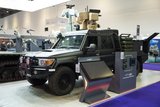Mercury Computer Systems continues to enhance xTCA subsystems
Mercury Computer Systems, Inc., a trusted provider of high-performance, real-time embedded computing, announced enhanced xTCA subsystems for demanding applications. These new subsystems provide high density, multi-core processing power and next generation serial RapidIO, supporting twice the bandwidth of current solutions and delivering new Quality of Service capabilities.
The hardware base for these new subsystems includes the HCD2100, the first of a family of AMC supporting Freescale Semiconductor's family of QorIQ processors. There is also a new ATCA carrier module, the BCC-301, delivering 20 GBS of bandwidth with next generation Serial RapidIO switching, as well as supporting four AMCs. These new components are the first examples of Mercury's extensions to market-leading xTCA application capabilities.
Computer systems embedded in sophisticated communications equipment are called upon to perform complex calculations and deliver deterministic, low-latency responses. Examples include: Satellite Communications, where beamforming techniques are used to efficiently maintain high bandwidth data links; Telecommunications Test Equipment, which must be powerful and flexible to simulate new generations of handsets with a wide range of behaviors; and SATCOM Gateways, supporting extremely high data bandwidths for voice and data traffic.
"Mercury has unique expertise and experience in data plane integration, using combinations of general purpose processors, DSPs and FPGAs to deliver powerful, high bandwidth, low latency xTCA solutions," said Mike Katz, Director, Product Management at Mercury Computer Systems, Inc. "Today's enhancements maintain that tradition, increasing both processing power and system bandwidth for a balanced improvement in overall subsystem performance. We combine these enhancements with customization, integration and test services to support layering an application onto subsystems for faster development and deployment of new capabilities," Katz added.
The HCD2100 is the first Mercury AMC module to support the Freescale QorIQ Communications P4 Series Architecture processor running at up to 1.5 GHz. It is well suited to providing high-performance computing for applications as diverse as wireless base stations, test and measurement in telecom, wafer lithography, and silicon inspection. "Freescale and Mercury have a long track record of collaborating to drive innovation within a wide range of markets," said Glenn Beck, Industrial Segment Market Manager of Freescale Semiconductor. "With Mercury's support for our QorIQ architecture, Freescale customers can now maximize the performance of highly compute and I/O intensive applications, general-purpose embedded computing systems in the networking, telecom/datacom, military and aerospace markets," he continued.
The BCC-301 is a next generation Carrier Blade for 4 AMCs, supporting both GigE switching and 20 Gbps serial RapidIO with multicast support for high-bandwidth low latency applications. It enables modular AMC configurations and is scalable with 2-, 5-, 6- and 14-slot ATCA chassis options. The BCC-301 uses the new CPS-1848 switch with enhanced diagnostics. "The BCC-301 doubles the bandwidth previously available for serial RapidIO, improving efficiency and significantly amplifying performance," said Stephane Gagnon, Director of Product Management of IDT. "This new carrier blade is further evidence of Mercury's commitment to driving technology and supporting a wide variety of network, telecom, industrial control, test and measurement, and defense applications," Gagnon added.
Source: Mercury
More from Digital Battlespace
-
![Babcock nears first customer for Nomad AI translation tool]()
Babcock nears first customer for Nomad AI translation tool
Nomad can provide militaries with real-time intelligence, saving critical time on the battlefield.
-
![AUSA 2025: Israel’s Asio Technologies to supply hundreds of improved Taurus tactical systems]()
AUSA 2025: Israel’s Asio Technologies to supply hundreds of improved Taurus tactical systems
Taurus operates alongside the Israel Defense Forces’ Orion system which supports mission management across tens of thousands of manoeuvring forces, from squad leaders to battalion commanders.
-
![AUSA 2025: Kopin pushes micro-LED plans as China moves faster]()
AUSA 2025: Kopin pushes micro-LED plans as China moves faster
The plan for the new displays follows fresh investment in Kopin’s European facilities by Theon and an order for head-up displays in fielded aircraft, with funding from the US Department of Defense.
-
![AUSA 2025: Persistent Systems to complete its largest order by year’s end]()
AUSA 2025: Persistent Systems to complete its largest order by year’s end
Persistent Systems received its largest ever single order for its MPU5 devices and other systems earlier this month and has already delivered the 50 units to the US Army’s 4th Infantry Division.
-
![Aselsan brings in dozens of companies and systems under the Steel Dome umbrella]()
Aselsan brings in dozens of companies and systems under the Steel Dome umbrella
Turkey has joined the family of countries attempting to establish a multilayered air defence system with government approval in August 2024 for the effort landed by Aselsan. Dubbed Steel Dome, the programme joins Israel’s Iron Dome, the US Golden Dome, India’s Mission Sudarshan Chakra and South Korea’s low-altitude missile defence system.
-
![DSEI 2025: MARSS unveils new agnostic multidomain C4 system]()
DSEI 2025: MARSS unveils new agnostic multidomain C4 system
MARSS’ NiDAR system has been deployed using sensors from static platforms to provide detection and protection for static sights, such as critical infrastructure, ports and military bases.



























